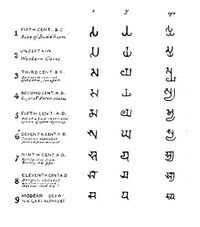Social:Conjunct consonant


Conjunct consonants are a type of letters, used for example in Brahmi or Brahmi derived modern scripts such as Balinese, Bengali, Devanagari, Gujarati, Tibetan, Dzongkha etc to write consonant clusters such as /pr/ or /rv/. Although most of the time, letters are formed by using a simple consonant with the inherent value vowel "a" (as with "k" ![]() , pronounced "ka" in Brahmi), or by combining a consonant with an vowel in the form of a diacritic (as with "ki" 12px in Brahmi), the usage of conjunct consonant permits the creation of more sophisticated sounds (as with "kya" 12px, formed with the consonants k 10px and y
, pronounced "ka" in Brahmi), or by combining a consonant with an vowel in the form of a diacritic (as with "ki" 12px in Brahmi), the usage of conjunct consonant permits the creation of more sophisticated sounds (as with "kya" 12px, formed with the consonants k 10px and y ![]() assembled vertically).[1] Conjuncts are often used with loan words. Native words typically use the basic consonant and native speakers know to suppress the vowel.
assembled vertically).[1] Conjuncts are often used with loan words. Native words typically use the basic consonant and native speakers know to suppress the vowel.
In modern Devanagari the components of a conjunct are written left to right when possible (when the first consonant has a vertical stem that can be removed at the right), whereas in Brahmi characters are joined vertically downwards.[1]
Some simple examples of conjunct consonants in Devanagari are: त + व = त्व (tva), ण + ढ = ण्ढ (ṇḍha), स + थ = स्थ (stha), where the vertical stroke of the first letter is simply lost in the combination. Sometimes, conjunct consonants are not clearly derived from the letters making up their components: the conjunct for kṣ is क्ष (क् + ष) and for jñ it is ज्ञ (ज् + ञ).
Some examples of conjunct consonants in Gujarati are: પ + ઝ = પ્ઝ (pjha) (where a stroke of the first letter is lost in the combination), હ + ળ = હ્ળ (hḷa), જ + ભ = જ્ભ (jbha). Sometimes, conjunct consonants are not clearly derived from the letters making up their components: the conjunct for śc is શ્ચ (શ્ + ચ) and for ñj it is ઞ્જ (ઞ્ + જ).
Conjunct consonants are used in many other scripts as well, usually derived from the Brahmi script.[2] In Balinese, conjunct consonants are called Haksara Wrehastra.[3]
See also
- Devanagari conjuncts
- Consonant stacking
References
- ↑ 1.0 1.1 Shapiro, Michael C. (1989) (in en). A Primer of Modern Standard Hindi. Motilal Banarsidass. p. 23. ISBN 9788120805088. https://books.google.com/books?id=vvuP8sD1wloC&pg=PA23.
- ↑ Tuṅga, Sudhāṃśu Śekhara (1995) (in en). Bengali and Other Related Dialects of South Assam. Mittal Publications. p. 163. ISBN 9788170995883. https://books.google.com/books?id=lRRYBHQvXdsC&pg=PA163.
- ↑ Shadeg, Norbert (2014) (in en). Tuttle Balinese-English Dictionary. Tuttle Publishing. p. 11. ISBN 9781462910786. https://books.google.com/books?id=20ktBAAAQBAJ&pg=PA11.
 |
